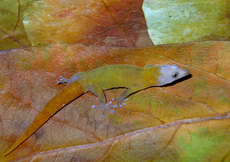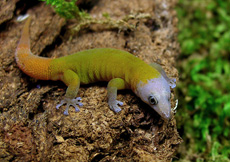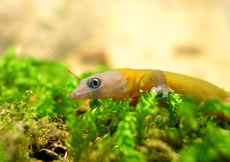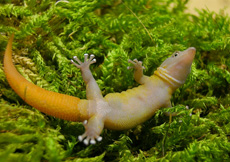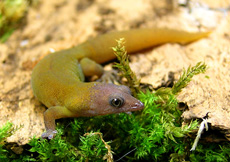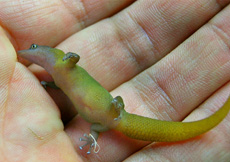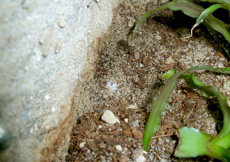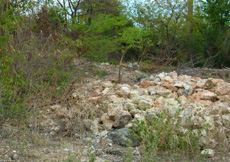Sphaerodactylus siboney
(FONG & DÍAZ, 2004)
Distribution:
There is only three known occurrences of Sphaerodactylus Siboney, these are east of the bay of Santiago de Cuba (FONG & DÍAZ, 2004). This species is named after the locality of the holotype found in Siboney.
Description:
Sphaerodactylus siboney is fully grown at about 6.5 centimeters, though the animals appear larger because of their stocky stature. Females are a few millimeters larger than males. The species has round pupils, which characterizes them as being diurnal. Above the eye cilary scales are present like with other animals in the genus. The dorsal scales are fine and granular.
The males base color is yellow-brown with a clearly distinct white-gray head, the tail is orange. The coloration of the females is like the males, but are somewhat less defined. Males have bright rows of scales between the hind legs, the so-called Escutcheon, which are lacking in females.
Habitat:
Sphaerodactylus siboney inhabits dry areas with a steppe-like character and dry coastal areas. Animals may be found under stones, in leaf litter, dead agaves and Tillandsia fasciculata. They share their habitat with Sphaerodactylus notatus and Sphaerodactylus dimorphicus (FONG & DÍAZ, 2004).
Husbandry and Breeding:
A terrarium with an edge length of 30 centimeters is suitable for this larger Sphaerodactylus. Intra-sex aggression has shown to be very high so a group would not be advisable, a pair has proven to be fail safe, however the animals can be kept individually as well. In nature Sphaerodactylus siboney is primarily found under stones, therefore they should not be left out from the enclosure. The walls of the enclosure are best decorated with faux rock. The substrate should consist of a sand soil mixture in a ratio of 3/4-1/4. Stones may be stacked on the ground to offer the animals a safe retreat between the crevices. Care must be taken when stacking so the animals are not crushed, best is to silicone the stones together so they cannot fall. Some live plants such as Peperomia, Pilea, Sedum and Bromeliads may also be used in the decor. A shallow bowl of water and a bowl of crushed up cuttlefish bone should also be provided to the animals. To achieve the necessary humidity of 60-70%, the terrarium should be misted once daily. Daily temperatures should range between 28-30°C (82-86°F), at night the temperature should drop by at least 4 degrees. Midday the animals should be offered a basking spot location that reaches around 35°C (95°F). Illumination consists of 1-2 fluorescent tubes switched on daily for 12 hours. If the bulbs are not sufficient enough to achieve the required temperatures, an additional heat mat should be attached to the back wall. Under no circumstances should a heat mat be mounted under the terrarium as the substrate would dry out too much, killing any buried eggs and possibly the geckos! Animals may be fed twice weekly with small crickets, isopods, firebrats, Drosophila, aphids, and springtails. Isopods and springtails should also be constantly present in the tank. All food should be dusted with the appropriate supplements at every feeding.
To halt breeding in winter to allow the females a proper resting phase, any spotlight should be turned off, the illumination time should be reduced to 8 hours and the maximum temperature should not exceed 24°C (75°F). A gradual increase of temperature and illumination may begin again in spring. Following a successful mating the female lays a single egg every 3 weeks. Up to 8 eggs will be deposited in a single breeding season. Usually the eggs are buried in the substrate and only very rarely will they be placed under any decor. It is not yet known if the adults go after the young, so the eggs are best removed from the enclosure and moved to an incubator. At a constant incubation temperature of 28°C (82°F) and 70% humidity the young emerge between 70-80 days measuring 3.2 centimeters. At first the young will be uniformly brown, but 3-4 weeks later they will resemble the coloration of their mother.
To date rearing with other species of Sphaerodactylus in converted household containers has proven to be successful. Containers should be decorated with soil, pieces of bark and a live plant. A surface mounted fluorescent tube is used both for lighting, as well as heating. They young are fed a varied diet of micro crickets, springtails, aphids and small firebrats every two days. All food should be dusted with the appropriate supplements at every feeding. At around 6 months it is usually possible to determine their sex and at one year they reach sexual maturity and can be bred with.
Sphaerodactylus siboney was first described in 2004 and is therefore still relatively rare among European hobbyists, with a little luck you can be able to breed these lovely animals! The species is quite curious, and thus often seen in captivity. Even a feeding with a pair of tweezers is not unusual with these animals. The disadvantages of this species however are the difficulty in tracking down the eggs and the animals' speed. Should one have experience with other members of the genus, you will also have joy and ease with this beautiful animal!
Literature:
- Fong, A. & Díaz, L. (2004): Two new species of Sphaerodactylus (Sauria: Gekkonidae) from the southeastern coast of Cuba. SOLENODON 4: 73-84.
